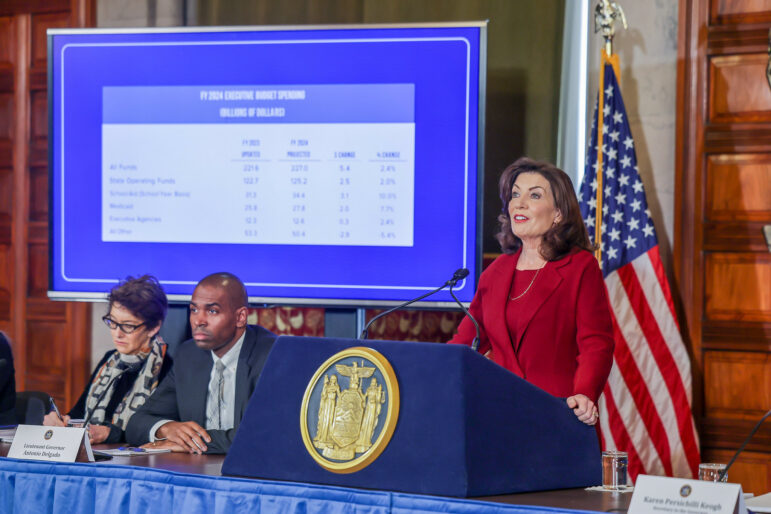“During times of austerity, there are always some who wish to undermine [Managed Long Term Care (MLTC)] programs. That would be extremely detrimental for tens of thousands of vulnerable New Yorkers.”

Mike Groll/Office of Governor Kathy Hochul
Gov. Kathy Hochul and other state leaders presenting budget plans last year.Care managers, assessment nurses and home care workers are superheroes who find innovative solutions to complex problems. While that is the case across the health care sector, it is particularly true for those who work with New Yorkers enrolled in Managed Long Term Care (MLTC) plans.
Unfortunately, as state legislators and policymakers look for ways to close the state’s looming $4.3 billion budget deficit next year, MLTC and other Medicaid programs could face cuts. In response to the state budget director’s mid-fiscal year review in November, budget hawks called for reforms to make Medicaid programs more efficient.
This is a familiar pattern. During times of austerity, there are always some who wish to undermine MLTC programs. That would be extremely detrimental for tens of thousands of vulnerable New Yorkers. To understand why, consider some stories about the people we serve.
A member with schizophrenia and substance issues lost her apartment after a hospitalization. She spent some time wandering the streets, confused and alone. Based on the relationship that had been forged, she was only willing to take calls from her care manager, but the member was unable to identify her location. The team worked tirelessly with law enforcement to locate her and ensure that she was safe. After 200 nursing homes refused to accept her, her care manager reached out to her brother, and he agreed to take his sister in. With the help of her entire MLTC support team, she regained stability in her life.
None of that would have happened without her dedicated MLTC care manager who built trust with the member and is familiar with her life circumstances.
The same is true for Jonathan, who was an innocent victim of a drive by shooting. In an instant, the 29-year-old went from being an employed father of an 8-year-old son to a quadriplegic completely dependent on others for everything. Over the next two decades, he developed a deep relationship with his care manager, assessment nurse and home care workers, who he credits with saving his life.
There’s also the Egyptian-born man who emigrated to Brooklyn in the 1970s and worked hard to build a life in America—until 12 years ago when he suffered a spinal cord injury as the result of an accident. He is now a bedbound quadriplegic who is supported by his loving daughter (who lives out-of-state), and his MLTC plan’s interdisciplinary care team. In addition to round-the-clock in-home assistance, he has a care manager and assessment nurse who interact with his primary care physician, specialists, and home care workers to ensure he is getting the right care at the right time.
These are just three examples of the hundreds of thousands of at-risk New Yorkers served by MLTC plans in every community across the state. The common thread linking them all is the commitment of their teams and the innovative, personalized approaches to the care plans they develop and oversee, with members directing their own care, that allow our most vulnerable populations to thrive in their own homes and communities.
Unfortunately, our innovative model is perpetually at risk. Whenever budgets get tight, politicians look to Medicaid spending for cuts. Already, state agencies have been directed to freeze spending levels next year.
As it is, reforms that were included in the state budget last year reduced the number of MLTC plans in New York. And while the state budget director called for using a scalpel to find savings, we’re worried that the tools could quickly give way to an axe, particularly as shortfalls are projected to swell until at least 2027.
That’s why sharing the stories of our members is so important, not only to commend the care managers, assessment nurses, support teams, home care workers and partner agencies for their dedication and professionalism, but also to underscore the essential role of the MLTC program in keeping elderly or disabled New Yorkers as healthy and independent as possible in the community of their choice.
Any changes to MLTC programming will cause irreparable harm to the most vulnerable among us, at a time when the demand for our services is likely to grow. New York has one of the oldest populations in the country and a growing number of elderly and disabled residents who are already living on the margins, a number that will surge as Baby Boomers age.
Albany needs to recognize the importance of these critical services now and in the future by preserving and protecting MLTC plans. That means avoiding cuts once budget negotiations begin in January that would erode and diminish this vital service.
Diana Gelfand is the chief clinical officer Elderplan/HomeFirst, a member of MJHS Health System.








